Building a Multi-Stage Water Filter — Lessons From 3 Weeks Off-Grid
Complete engineering guide for building a premium overlanding water system. Includes CAD files, component specifications, and lessons learned from real-world testing in challenging conditions.

Having access to clean and safe water is extremely important - at home, while travelling and also in emergency situations. Most importantly, you have to rely on your equipment that it will work in extreme conditions and that its easy to maintain and fix - with simple tools and also in remote locations.
In this article I will go about the main requirements for our custom & portable water-filtering system and why it was important for us to build a custom system. In a follow-up article I will dig deeper and tell you about actual the build process, the wiring scheme and things to watch out for. Building this system required some research in finding perfectly matched components, as this is the basis for a reliable and long-lasting system.
Available December 2025 — Register now for early access!
The first professional, field-tested guide to building a safe overlanding water system.
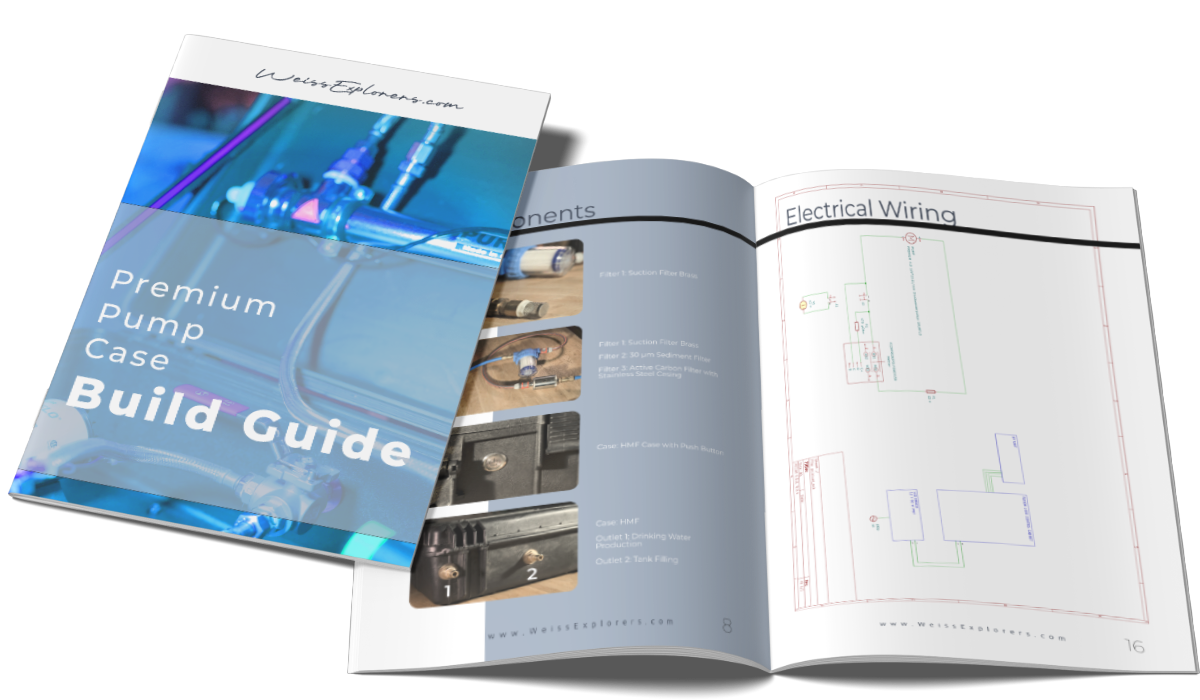
Subscribers will be notified first when the guide is released.
Now lets get back to the requirements and details of our portable water filtration solution ...
Problem 1 - Limited Space Available
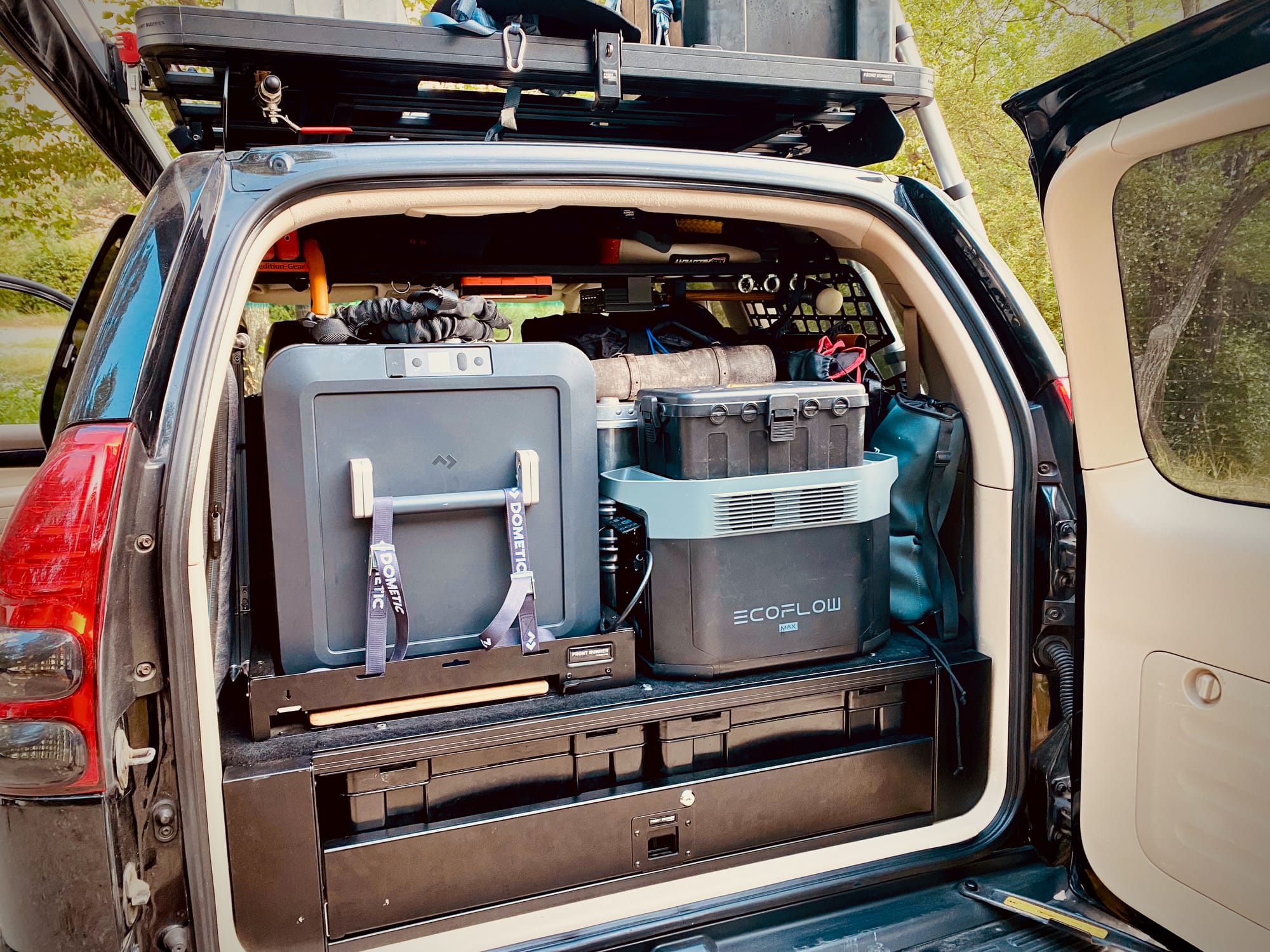
We have a Toyota Land Cruiser J120 in which we have to fit all of our equipment - in the back and on top of the vehicle. Since we are four people, we have a lot of stuff.
Fitting a stationary pump into the vehicle wouldn't be such a difficulty - but the filters and the wiring also need to find space inside the vehicle to be protected from dirt and water. Flexibility was also a major requirement for us while our LC is used as a daily and for overlanding trips as well. Having a fixed installation reduces flexibility and you may run into issues when transporting large and heavy items in the trunk, potentially breaking all that is permanently installed. The next problem is accessibility - and being able to change or repair a broken component of a water-filtering system.
Problem 2 - Dealing with Different Situations
Different water sources & varying water qualities are found during our travel across mainland Europe. We started with our overlanding adventure with our first long trip from northern Italy, through southern France to northern Spain. In just 2 1/2 weeks we travelled over 4500 km and experienced vast & awesome landscapes. Read more here ...
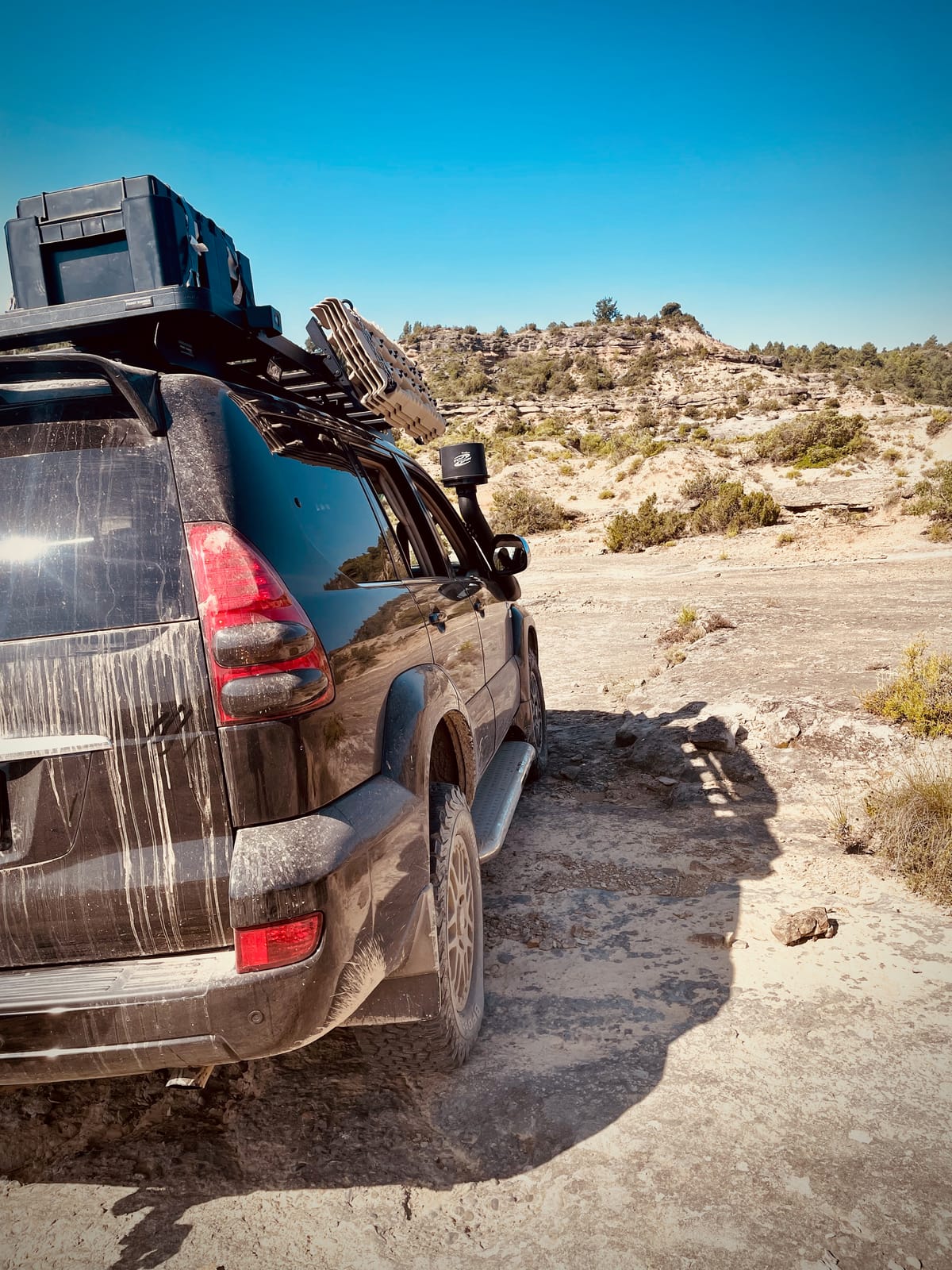
Collecting Water from the River / Scenario 1
Collecting water from a river may be one way to fill up your tank. Depending on the location and the access to flowing water. However, there some things to consider before safely taking water from a stream.
Taking water from a river may be risky since you never know about the water quality. Clear water does not mean that its safe to drink. There are some indicators of good water quality, e.g. when organisms like mayflies, crayfish thrive in these waters. Another good indicator is when watercress growing in the stream. This plant is very easy to identify with some experience and if you taste a leaf, it has a distinct spicy and mustard-like taste.
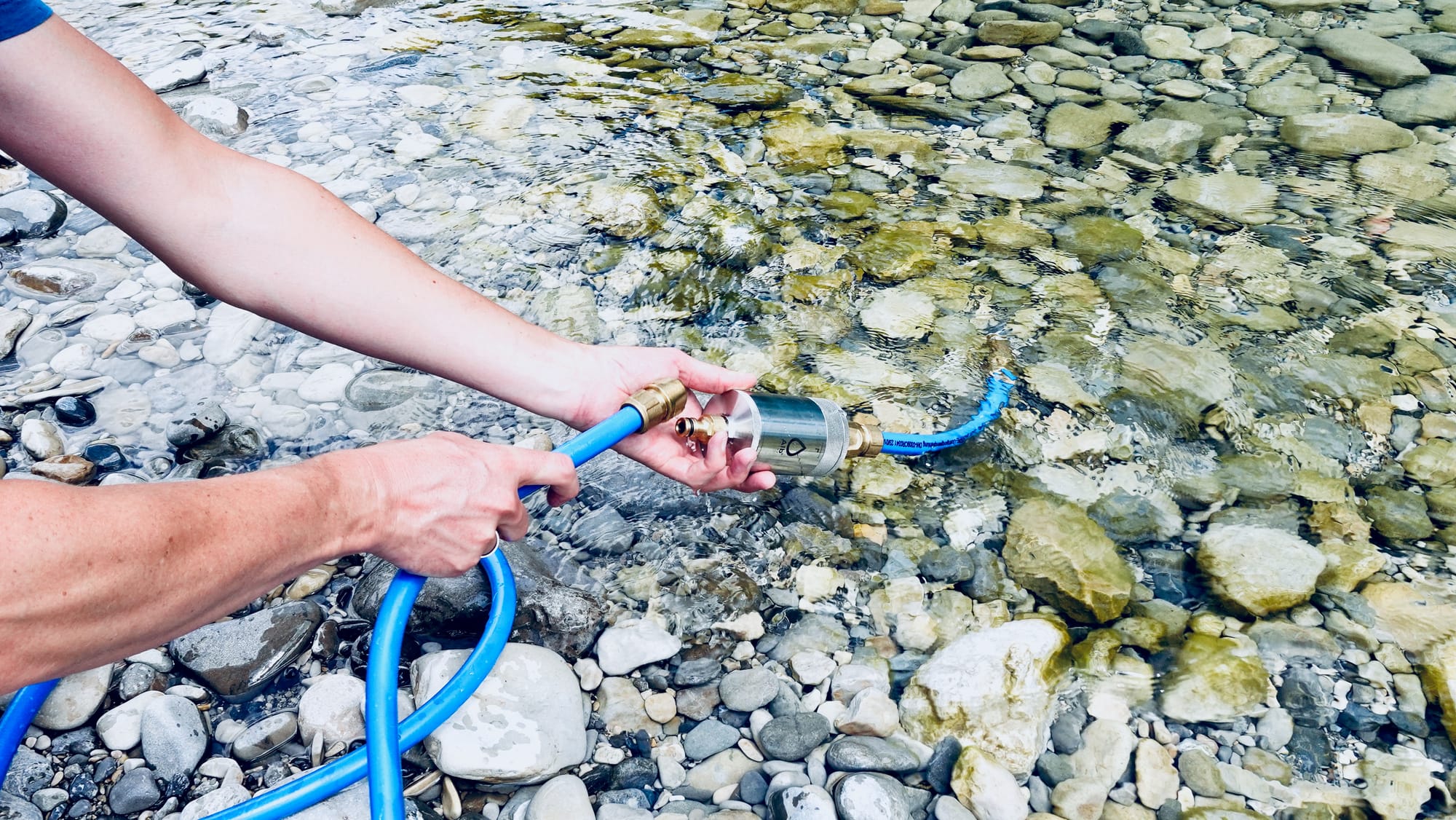
Another possibility is to test the water for common indicators like nitrate, pH using test strips. These can be ordered online and can test for 16 different substances. Not very accurate but you can get an idea about the overall quality.
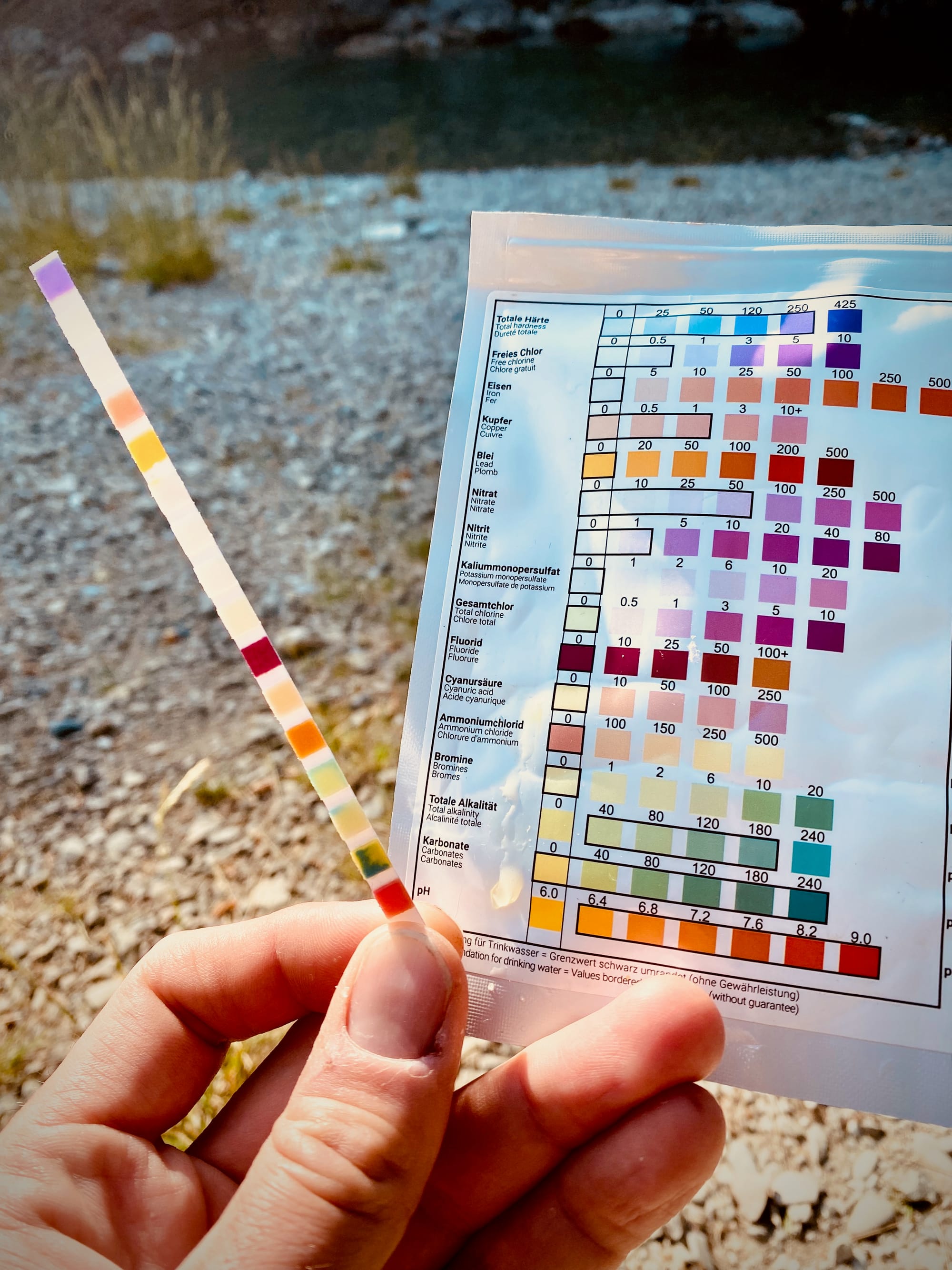
Producing Safe and Clean Drinking Water / Scenario 2
Pulling water from the tank can be done using gravity, however, filtering stale tank water is crucial to remove odors and bacteria from biofilms that may grow inside the tank.
To be safe, the main filtering stages need to come after the tank, and pressure needs to be applied to push water through the filters effectively.
So, in the end it's important to ensure water safety even if you fill up the tank with clean water in the first place. Storing it inside the tank in warm temperatures and under light exposure can cause serious issues through initial contamination - which we can never fully rule out - or by secondary contamination.
We should definitely filter the water right before using it—make sure you have a reliable filter system!
The Combination of the 2 Scenarios
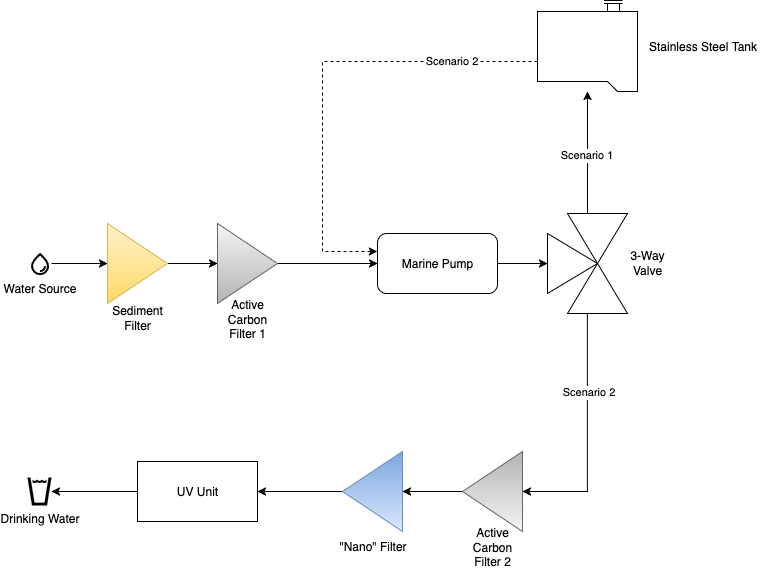
Problem 3 - Stale Water in the Tank
We have a 40 liter stainless steel tank on top of the vehicle, which can last a few days for cooking, showering and for drinking water.
The material of the tank also has a great impact on the safety of the water. Most water tanks for overlanding are made of plastic because they are cheap and easy to produce. Plastics tanks, especially if the material is non-food grade are a huge health concern, especially when being exposed to high temperatures and UV radiation from the sun.
Prior to our stainless steel tank we had a black polyethylene tank for 42 liters from Front Runner. Front Runner itself states that the PE material is food-grade:

Prolonged high-temperature and sunlight exposure can accelerate the degradation and diffusion of additives and UV stabilizers from the material into the water (source: PMC)
In the end, having a stainless steel tank does not keep your water from getting stale and becoming unsafe to drink. Most importantly, stainless steel will not leak any chemical solvents, additives and stabilizers into your water supply and it will certainly not get brittle and degrade from temperature and UV exposure.
So the solution was to develop a portable water filtering and pumping system, which is robust and can handle well under different situations, e.g. pumping water from a river to the tank or filtering it directly. Also, filtering the water from the tank to be used directly for drinking or showering.
Combining a portable pump with an integrated filtering system could help us in any situation on the road, no matter what water source and what water quality we may encounter. Stale tank water is no problem anymore. The best part is, we do not need to treat our water with any chemical agent to make it drinkable. Also, we reduce a lot of trash as we don't need to buy bottled water.
Across Europe, water quality varies greatly. After severe weather events or heavy rainfall, it’s not uncommon for wastewater treatment plants to reach their limits. In such cases, excess water may be discharged without full treatment, contaminating rivers and local water supplies.
When we travelled through Slovenia, we once wanted to fill our tank from a house connection. Luckily, we learned just in time that it wasn’t potable water — and at that time, we didn’t yet have our own filtration system on board.
The same applies to natural water sources. Invisible dangers such as protozoa, bacteria, or heavy metals can be present even in crystal-clear streams. Especially when travelling in unfamiliar regions, extra caution is essential.
Protecting our health means relying on a safe and durable filtration system — one that doesn’t add its own problems through cheap plastic components. That’s why I build my systems primarily from stainless steel and premium-grade parts, ensuring that every drop of water is as pure and safe as it should be.
What CAN be Filtered with the Pump Case?
Inside the pump case we use a activated carbon filter, a hollow fibre membrane filter with a pore size of 0.1 µm and a UV unit. The following compounds can be filtered with this setup effectively:
- Micro plastics
- Odors
- Bacteria
- Viruses
- Sediments
- Asbestos
- Yeast
- Pollen
- Heavy metals
- Pesticides
- PFAS*
- Pharmaceutical residues*
What CANNOT be Filtered?
- Nitrates and other ions as they can only be removed using an ion exchanger
- Endotoxins
The Filter Stages in Detail
Water is often filtered by using membranes which have a specific pore size distribution often indicated as 0.1 µm log (average pore size). The actual pore size varies significantly and the largest pores can have a diameter of +30%! Different membrane technologies include:
- Microfiltration
- Ultrafiltration
- Nanofiltration
- Reverse Osmosis
Read more about the water filtration basics!

Inside the pump case I am using a "Nano" membrane filter from Alb Filter. From the technical description, you will see that contradictory information have been provided by Alb Filter. The filter is marketed as "Nano" filter with a pore size of 0.1 µm. However, the pore size 0.1 µm clearly falls into the transition between Microfiltration and Ultrafiltration, far away from Nanofiltration. This is misleading, even if the pore size of the filter is 0.1 µm or 100 nm.

It is true, that this filer can remove bacteria, asbestos and micro plastics from the water but it cannot protect you from viruses.
I added a UV unit behind the hollow fibre membrane filter which acts as a final sterilization for the water. UV sterilization works by damaging the genetic material of harmful microorganisms, preventing them from reproducing. This makes it highly effective against both bacteria and viruses commonly found in natural water sources.
The Solution
Developing A Portable Water Pump & Filtering Unit
Building a portable water filter and pump case was a great project where I could use my experience from plant engineering for water management for a real outdoor solution that would be very handy for overlanding.
Having a portable, rugged and capable tool to cope with many different situations and to produce clean and fresh drinking water was the main goal in developing this pump case.
Parts list & System Overview
- Pre-filter including a 30 µm sediment filter + activated carbon filter
- 12 V Shurflo Aqua King II
- Activated Carbon Filter
- Hollow Fibre Filter
- UV Unit
- Control Cabinet for UV Unit
- Pressure Reducer
- 3-Way Valve
- 2-Pole Push Button
- Ball Valve
- and much more ...
Sign up for our newsletter and get a complete DIY guide for building your own pump case today.
Already a Member? Download the Pump Case Blueprint here.
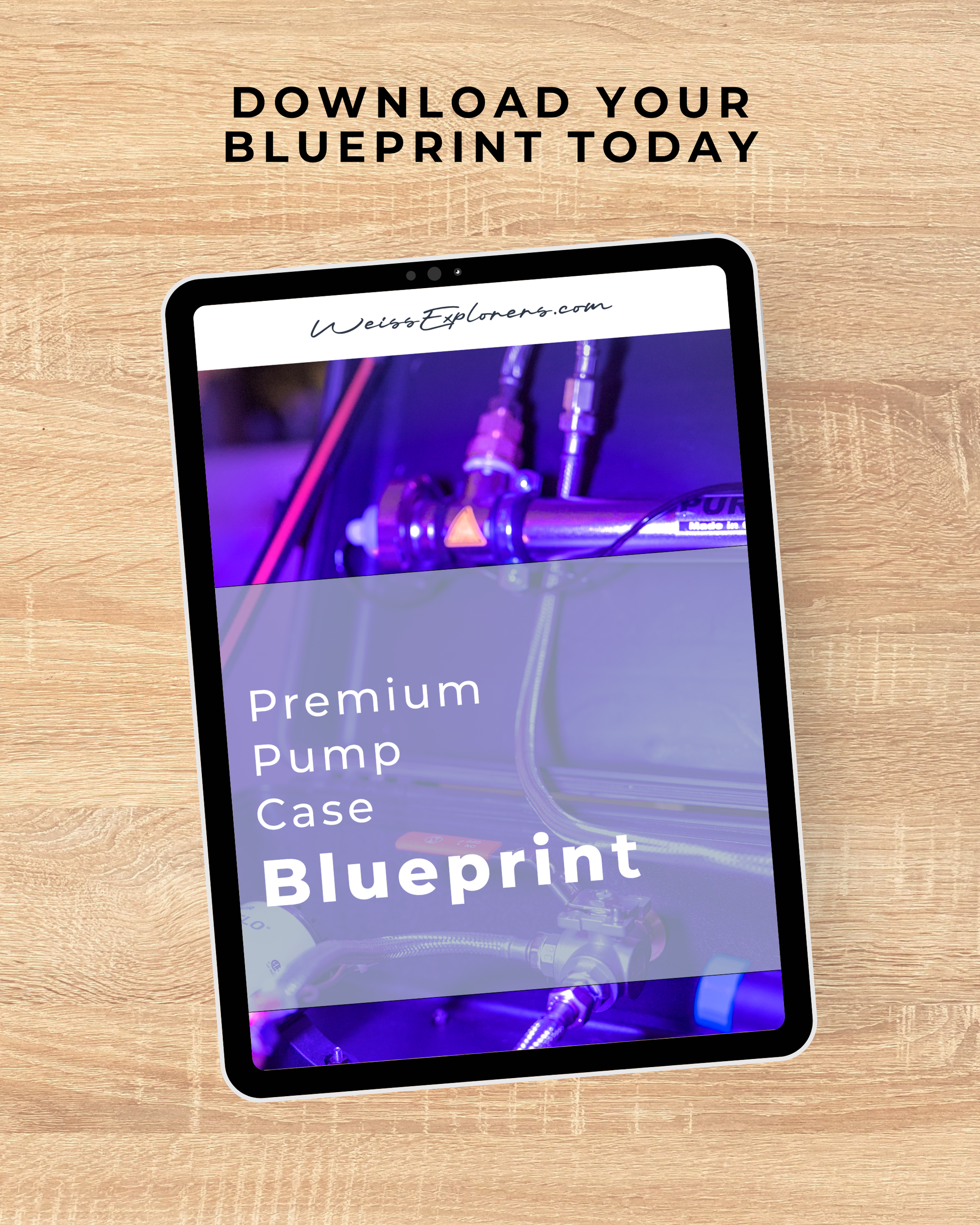
Use Cases
The pump case has one inlet and two outlets with each one serving a different use case:
- Scenario 1: Tank Filling & Pre-Filtration: pumping water from the ground source to the tank and filter it to a certain degree.
- Scenario 2: Drinking Water Production: pumping water from the tank or any other source and make it drinkable.
The pump case has two outlets and one inlet. Diverting the water two a specific outlet is done by a three-way valve. Watch out as there are two major differences available for the three-way valves: type L- and type T-bore. For this case we need to use a type L-bore - this is really important.
Pumping Water from Source to the Tank
Filtration stages:
- Pre-filtration with metal mesh
- Sediment filter 30 µm pores
- Activated carbon filter
Producing Drinking Water from the Tank
Filtration stages:
- Activated carbon filter
- "Nano" filter with 0.1 µm pore diameter
- UV sterilisation unit
Read more in the article about water filtration basics!
Producing Drinking Water from any source
Filtration stages:
- Pre-filtration with metal mesh
- Sediment filter 30 µm pores
- Activated carbon filter
- "Nano" filter with 0.1 µm pore diameter
- UV sterilisation unit
Why are all these stages necessary?
First, to protect the pump and the activated carbon filter, we need to use a metal mesh to catch very coarse sediments, leaves, and other things flowing in the river. The second, finer 30 µm filter is needed to filter smaller particles. This also helps to prevent the activated carbon filter from becoming clogged too quickly. The key point is that the filter does not cause a significant decrease in pressure. This allows the pump to continue drawing water through an air-filled hose. Before this, I was using a standard pre-filter from Alb Filter. This one was made from paper, and it had a high pressure loss. This meant that the pump couldn't draw water through the filter. Therefore, I needed to switch the pre-filter ...
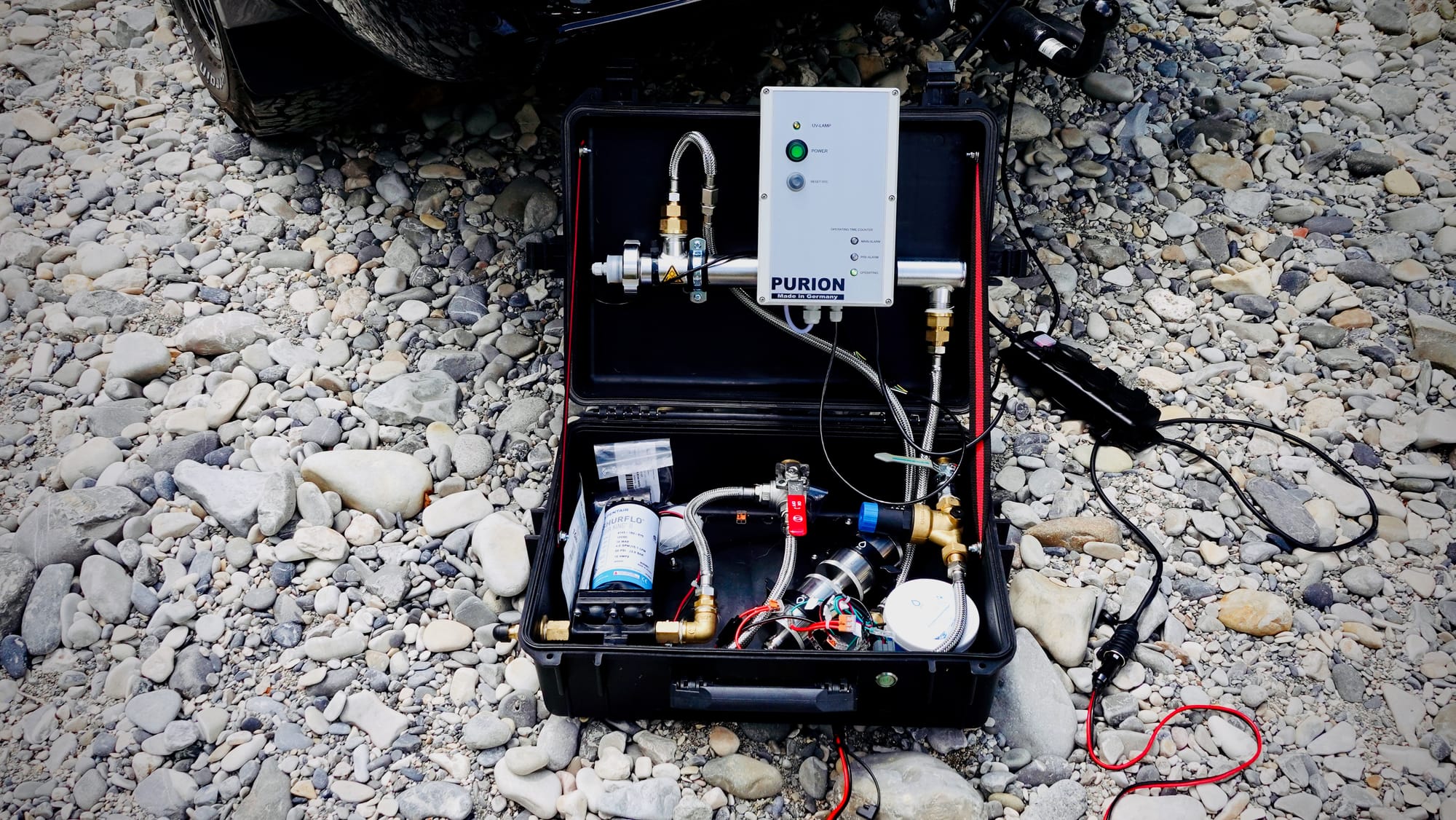
Pump Performance & UV System
The pump case has an effective flow rate of 10 liters per minute (2.64 gpm) behind all filters. This was important to know to choose the correct UV unit for the job. The stainless steel UV units come in different sizes for specific flow rates. The size of the UV system ensures that the specified amount of water receives optimal UV irradiation within a defined time.
Since the Pump is making 10 liters per minute, which equals 600 liters per hour the correct UV unit would therefore be the Purion 1000, designed for up 1000 liter per hour.
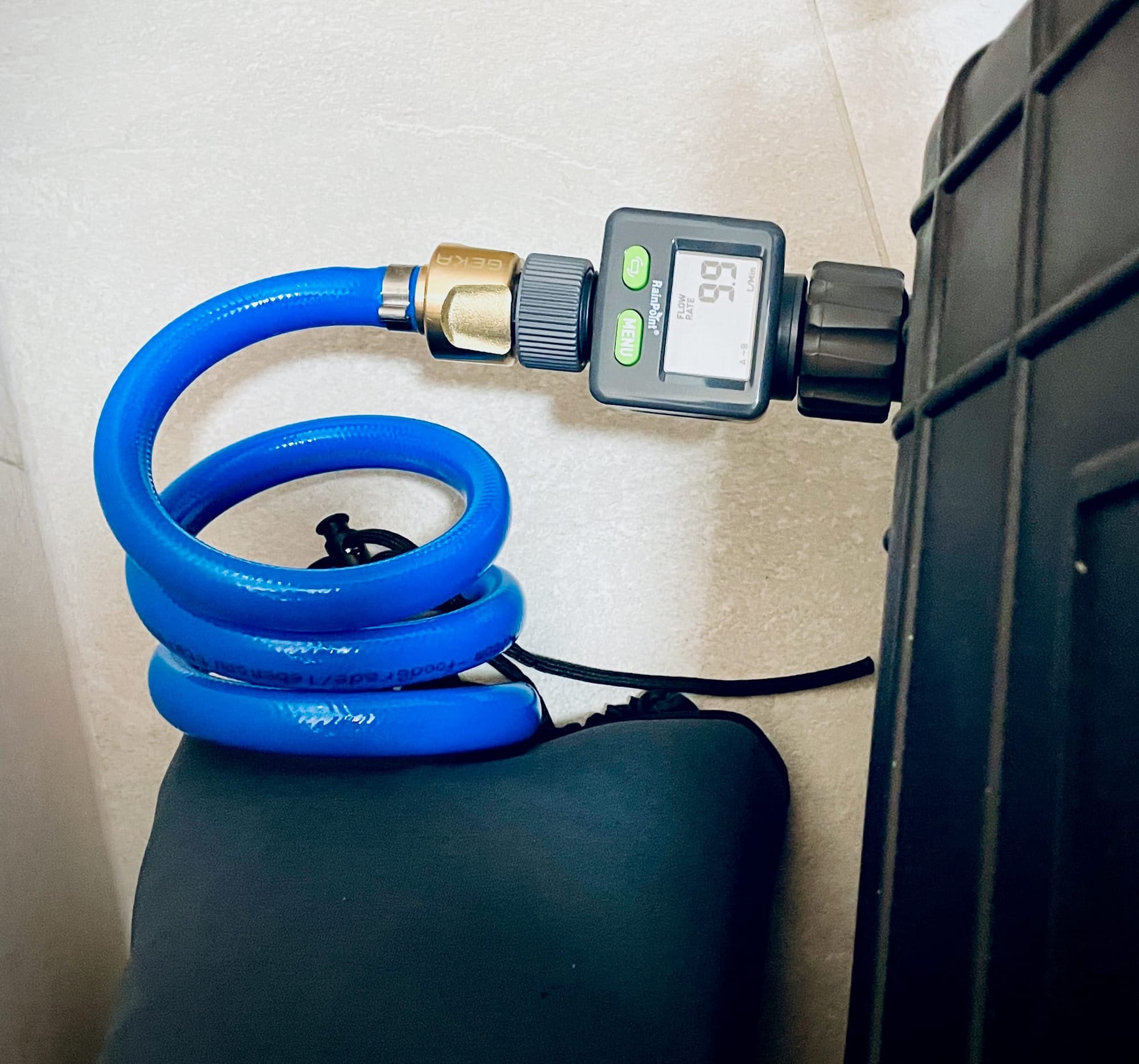
The Aqua King II will shut down when a certain pressure is reached inside the pipe. This protects the pump from overload and extends the service life of the diaphragm pump.
What Works Well?
Pumping water from and to the tank works very well, even with 10 meter hoses and filters between the connections (filters have a large pressure drop causing the water flow slower after the filter).
The hose connections made of metal also do their job very well. Sometimes the connection is too loose and the hose will fly away under pressure, but this is no serious issue 😺 Just seek shelter quickly if this happens!
What can be Improved?
UV Unit Setup
The wiring is currently very exposed which is not so optimal when dealing with water. The case needs to stay open with the junction box for the UV unit. This will be improved and I need to be able to close the case with the UV unit operating. The manufacturer ships the UV unit with a rather large junction box which I somehow have to include in the case and make it water proof. The UV lamp can be monitored using a sensor, guaranteeing that the UV lamp is operational. This comes in handy when operating the pump case with the lid closed.
The pre-filter for the activated carbon filter cannot be used under normal conditions
Normally I would use it in the feed line to the pump but since the hose is filled with air when pumping water from a river towards the tank, the hose will not fill up due to the high pressure drop across the pre-filter. The white filter on the right is the pre-filter for the activated carbon filter, having a high pressure drop.
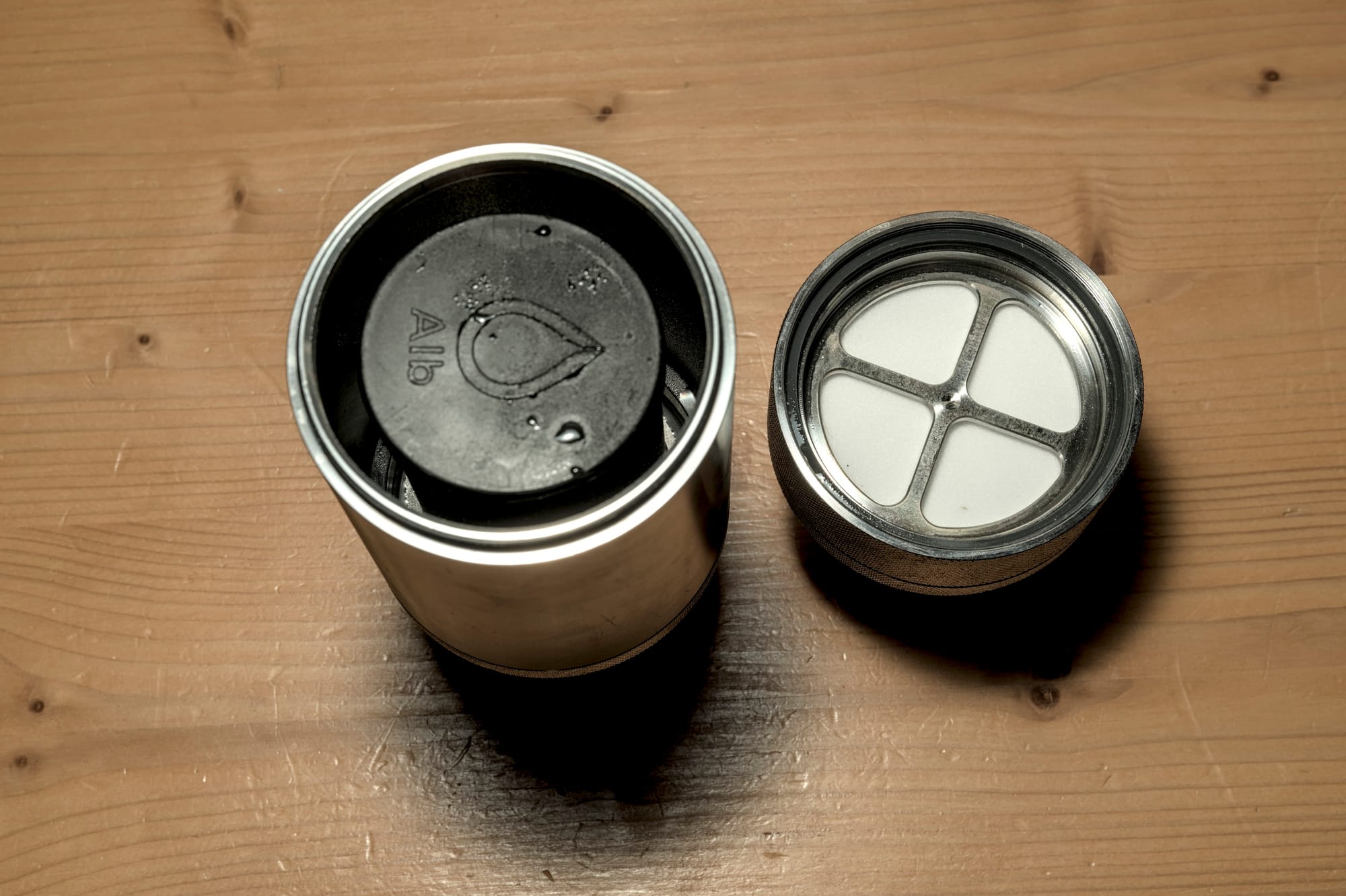
Running the pump without the pre-filter, the activated carbon filter quickly becomes clogged if there is a lot of sediment in the water. Here is a comparison of an active carbon filter before (left) and after (right) after approximately 10 liters of water with a high sediment load had been pumped through the filter.
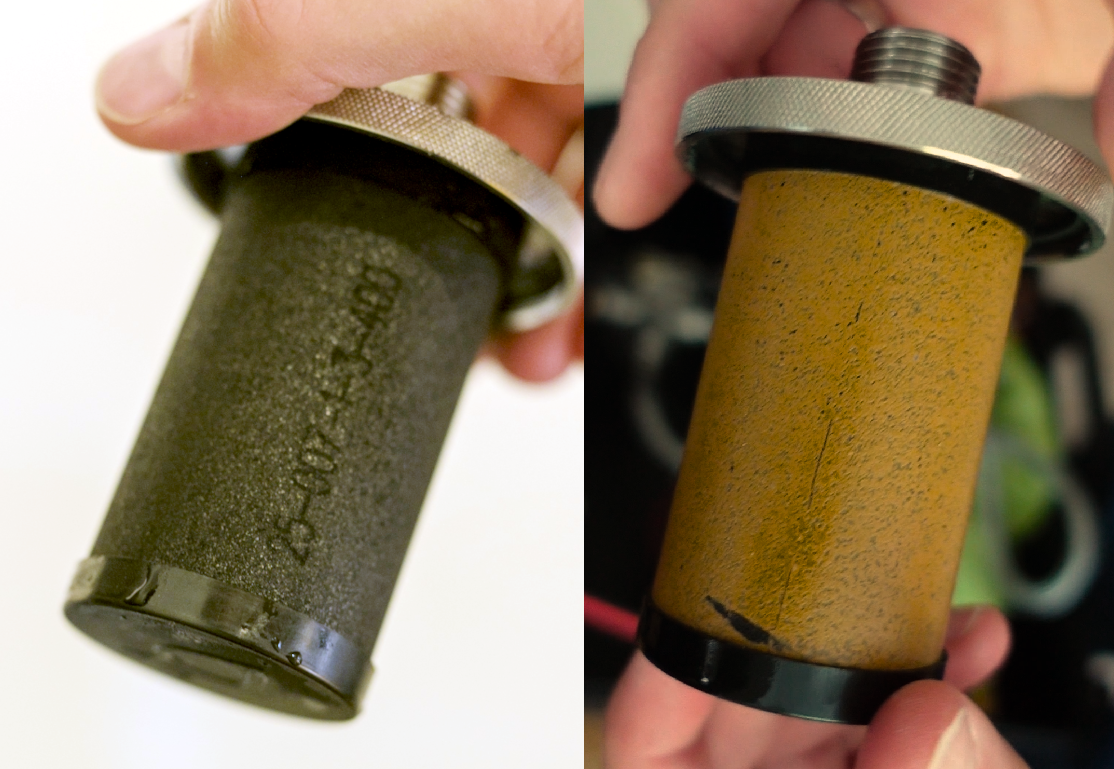
Since the designated pre-filter does not work in our setup, we decided to switch the pre-filter with a coarser pre-filter. Here are the options available ... Pentair produces mesh filters with mesh sizes ranging from 30 µm up to 5 µm, which will be tested next. We will see how the pump performs using these filters.

What's Next?
In an upcoming video, which I will link here, I am going to show you the pump case in action, filtering water with a high sediment load and I'll show you how the pre-filter from Pentair performs.
In part 2 of this series I am going to show you the complete build details of the pump case, including the electrical wiring and PID diagram.
Stay tuned and sign up to our newsletter for free and receive a detailed part list with suppliers and build details of the pump case!

